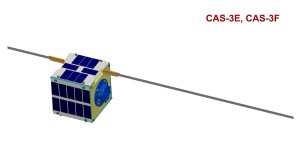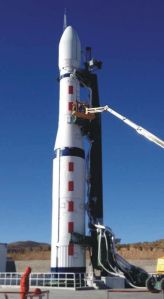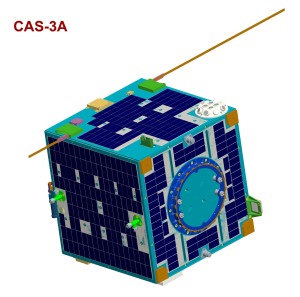The CAMSAT orchestrated XW-2 (formerly known as CAS-3) amateur satellite system was successfully launched on Saturday, September 19, 2015 at 23:01:14 UT on Beijing’s new Chang Zheng 6 (CZ-6) rocket from the Taiyuan Satellite Launch Center (TSLC) in Shanxi.
The XW-2 constellation comprises six satellites of different mass, a 20 kg, three 10 kg and two 1 kg. All six satellites are equipped with substantially the same amateur radio payloads, a 435/145 MHz linear transponder for SSB/CW communications, a CW telemetry beacon and an AX.25 19.2k/9.6k baud GMSK telemetry downlink. Each set of amateur radio equipment has the same technical characteristics, but operates on different frequencies in the 435 MHz uplink band and 145 MHz downlink band.
In addition to the XW-2 satellites three other satellites with amateur radio payloads were on the same launch. LilacSat-2 (CAS-3H) which has an APRS digipeater, 144/437 MHz FM voice transponder and SSB/CW linear transponder. DCBB (CAS-3G) and NUDT‐Phone‐Sat (CAS-3i) have telemetry downlinks.
CAMSAT has released these documents for the satellites:
• XW-2/CAS-3 Frequency Information Chart
• XW-2 CW Telemetry Encoding Format
Corrections to Frequency Information Chart:
– Frequency Allocation Diagram 453.000 MHz should read 435.000 MHz.
– LilacSat-2 FM voice downlink should read 437.200 MHz.
– LilacSat-2 has a Non-Inverting linear transponder not shown in the document
• 144.3425-144.3825 MHz Uplink
• 437.180-437.220 MHz Downlink
CAMSAT has worked closely with DFH Satellite Co. Ltd (government aerospace contractor) over several years to complete the project. Here are the technical details:
● XW-2A (formerly known as CAS-3A):
– Micro-satellite architecture
– Dimensions: 400Lx400Wx400H mm
– Mass: 20kg
– Stabilization: three-axis stabilization system with its +Y surface facing the earth
– Antenna: Deployable antenna, one 1/4λ monopole VHF antenna with max.0dBi gain is located at +Z side and one 1/4λ monopole UHF antenna with max.0dBi gain is located at –Z side, close to the each edge of satellite body
– Uplink: 435 MHz band
– Downlink: 145 MHz band
– Amateur radio payloads:
Callsign: BJ1SB
CW Telemetry Beacon: 50 mW, 22 wpm
435/145 MHz Linear Transponder: 100 mW, 20 kHz bandwidth, spectrum Inverting
AX.25 telemetry: 100 mW, 19.2k/9.6 kbps GMSK
 ● XW-2B, XW-2C and XW-2D:
● XW-2B, XW-2C and XW-2D:
– Micro-satellite architecture
– Dimensions: 250Lx250Wx250H mm
– Mass: 9kg
– Stabilization: three-axis stabilization system with its +Y surface facing the earth
– Antenna: Deployable antenna, one 1/4λ monopole VHF antenna with max.0dBi gain is located at +Z side and one 1/4λ monopole UHF antenna with max.0dBi gain is located at –Z side, close to the each edge of satellite body
– Uplink: 435 MHz band
– Downlink: 145 MHz band
– Amateur radio payloads:
Callsign: BJ1SC ( for XW-2B), BJ1SD ( for XW-2C), BJ1SE ( for XW-2D)
CW Telemetry Beacon: 50 mW, 22 wpm
435/145 MHz Linear Transponder: 100 mW, 20 kHz bandwidth, spectrum Inverting
AX.25 telemetry: 100mW, 19.2k/9.6 kbps GMSK
● XW-2E and XW-2F:
 – Cube-satellite architecture
– Cube-satellite architecture
– Dimensions: 110Lx110Wx110H mm
– Mass: 1.5kg
– Stabilization: Spinning stabilization using permanent magnet torquer
– Antenna: Deployable antenna, one 1/4λ monopole VHF antenna with max.0dBi gain is located at +Z side and one 1/4λ monopole UHF antenna with max.0dBi gain is located at –Z side, close to the each edge of satellite body
– Uplink: 435 MHz band
– Downlink: 145 MHz band
– Amateur radio payloads:
Callsign: BJ1SF ( for XW-2), BJ1SG ( for XW-2)
CW Telemetry Beacon: 50 mW, 22 wpm
435/145 MHz Transponder: 100 mW, 20 kHz bandwidth, spectrum Inverting
AX.25 telemetry: 100 mW, 9.6 kbps GMSK
The satellites were deployed into a 528 km by 551 km 97.5 degree inclination orbit. The NASA Orbital Lifetime Software provides an indication as to how long the satellites might remain in orbit before reentry into the Earth’s atmosphere:
• XW-2A = 8.5 years
• XW-2B/2C/2D = 9.2 years
• XW-2E/2F = 8.5 years
• LilacSat-2 = 18.2 years
The launch carried a total of 20 satellites of which 9 are known to be carrying amateur radio payloads. CAMSAT assisted the administration in Beijing to coordinate and allocate their frequencies.
A PDF of the satellite frequencies can be seen here.
NASA Orbital Lifetime Software http://orbitaldebris.jsc.nasa.gov/mitigate/das.html



You must be logged in to post a comment.